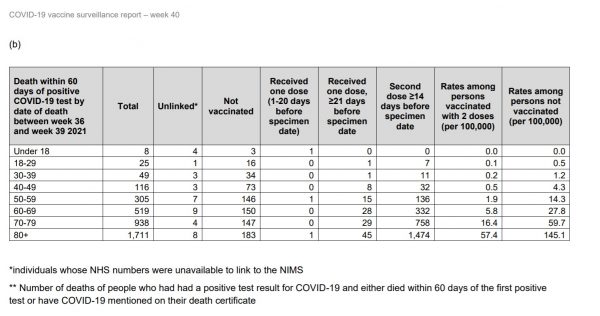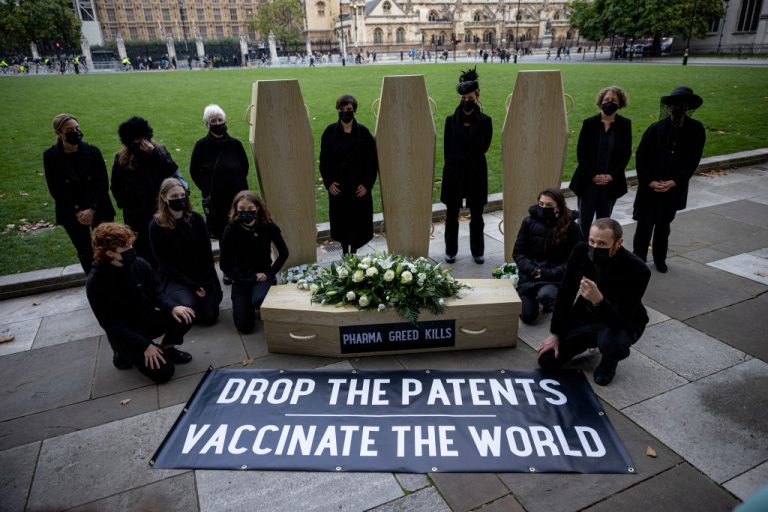A weekly intelligence report examining vaccine uptake rates, new positive Coronavirus Disease 2019 (COVID-19) case count, hospitalization, and death by a UK government health agency says that 98 percent of the country’s adult population has antibodies against SARS-CoV-2, the virus that causes COVID-19. Nonetheless, the majority of positive cases in demographics aged 40 and up are vaccine breakthroughs.
The report is weekly update #40 by the UK Health Security Agency (UKHSA) titled COVID-19 Vaccine Surveillance Report. The Summary says the UKHSA, which is formerly known as Public Health England, works with the Medicines and Healthcare Regulatory Agency (MHRA) and the NHS.
The update says that overall, 65.3 percent of the UK’s more than 67 million population has accepted one dose and 60.1 percent has accepted two doses of one of the country’s four approved gene therapy injections, noting that “coverage is highest in the oldest age groups.”
Under Population Impact, the report states that antibody coverage is almost universal in the country’s adult population, “Based on antibody testing of blood donors, 98.0% of the adult population now have antibodies to COVID-19 from either infection or vaccination compared to 19.0% that have antibodies from infection alone. Over 96% of adults aged 17 or older have antibodies from either infection or vaccination.”
In the Vaccine Effectiveness subsection, the UKHSA cautions of the same short 5 to 6 month time frame of protection granted by the new generation of vaccines as found in a similar U.S. Department of Defense-backed AI examination of 5.6 million vaccinated Medicare beneficiaries, “There is some evidence of waning of protection against infection and symptomatic disease over time, though protection against severe disease remains high in most groups at least 5 months after the second dose.”
Success
You are now signed up for our newsletter
Success
Check your email to complete sign up
Four of the first eight pages of the document are vaccine affirmative and vaccine promotional by nature. Two are the cover page and table of contents.
One paragraph makes the statement that vaccination is effective at preventing transmission, “Uninfected individuals cannot transmit; therefore, the vaccines are also effective at preventing transmission. There may be additional benefit, beyond that due to prevention of infection, if some of those individuals who become infected despite vaccination are also at a reduced risk of transmitting (for example, because of reduced duration or level of viral shedding).”
Other paragraphs state that today’s vaccines are 90 percent effective against both hospitalization and mortality, adding that a “relatively limited waning of protection” occurs “over a period of at least 5 months after the second dose.”
Data presented in a line graph format shows that between 80 and 95 percent of the UK population aged 50+ had accepted a single dose as early as Week 12 for the 50-55 group.
Similar figures are demonstrated for the second dose, but as early as Week 24 in the same age group.
The document says that in order to identify COVID-19 cases and deaths, it utilized the Second Generation Surveillance System (SGSS) and the UKHSA EpiCell deaths data, paired with the National Immunisation Management System (NIMS) against individual patients’ NHS number.
The method for defining hospitalized cases and deaths were outlined in the following way:
The outcome of overnight inpatient admission following presentation to emergency care, was limited to those occurring within 28 days of the earliest specimen date for a COVID-19 case.
Deaths include those who died (a) within 28 days of the earliest specimen date or (b) within 60 days of the first specimen date or more than 60 days after the first specimen date with COVID19 mentioned on the death certificate.
Positive Cases
The first data table provided measured the number of COVID-19 cases by vaccination status and age group between Week 36 and Week 39. In the first age subset, 18 to 29, the UKHSA found 67,820 positive cases where 23,440 were unvaccinated individuals, and in the 30 to 39 bracket, 81,532 cases were discovered with 21,449 unvaccinated individuals.
As age increases, the data skews sharply in the direction of breakthrough prevalence. In the 40 to 49 bracket, the number of positive cases increases to 101,094 with 11,662 unvaccinated. In the 50 to 59 bracket, case count falls to 70,731, but only 5,144 cases were in the unvaccinated.

Despite the raw data displaying a heavy proportion of breakthrough cases in the fully vaccinated, the UKHSA used two “rates among persons” vaccinated and not vaccinated columns based on numbers per 100,000 individuals that appear to show evidence to the contrary.
In the 18 to 39 bracket, this number is calculated at 688.1 per 100,000 unvaccinated and 409.6 per 100,000 vaccinated. In the 30 to 39 bracket, it’s 738.4 per 100,000 unvaccinated and 763.6 per 100,000 vaccinated.
The document is vague in revealing how this figure is calculated, “The rate of COVID-19 cases, hospitalisation, and deaths in fully vaccinated and unvaccinated groups was calculated using vaccine coverage data for each age group extracted from the National Immunisation Management Service.”
It appears the calculation is a weighted measure of absolute case counts utilizing the ratio between vaccinated versus unvaccinated individuals in each age bracket. The implication being that although there are more (sometimes substantially) breakthrough cases in terms of raw data, there are 3-5 times as many vaccinated as unvaccinated individuals remaining in society.
Hospitalization
Both the raw data and the rates per 100,000 calculation were substantially more flattering for proponents of vaccination in the hospitalization and death counts section, however.

In a second table measuring cases that presented to emergency care and resulted in an overnight inpatient admission that also occurred within 28 days of a positive test specimen, the data showed that in the 18 to 29 and 30 to 39 brackets, the majority were unvaccinated individuals.
However, as age increased, so did the proportion of breakthrough cases, beginning again at the 40+ mark.
In 18-to-29 year olds 348 total hospitalizations occurred with 241 unvaccinated, expressed as rates of 1.1 per 100,000 vaccinated and 7.1 per 100,000 unvaccinated, while 30 to 39 showed 588 total with 396 unvaccinated, expressed as rates of 2.2 vaccinated and 13.6 unvaccinated per 100,000.
But in the 40 to 49 bracket, the raw data became more balanced at 769 total cases with 388 unvaccinated, expressed as rates of 5.1 vaccinated and 23.0 unvaccinated per 100,000.
In the 50 to 59 bracket, 870 total cases were found with 359 unvaccinated. This figure was expressed as rates of 6.6 vaccinated and 35.1 unvaccinated per 100,000.
This data manipulation method resulted in the UKHSA stating, “The rate of hospitalisation within 28 days of a positive COVID-19 test increases with age, and is substantially greater in unvaccinated individuals compared to vaccinated individuals.”
Death
The update calculated the number of deaths that occurred within 28 days of a positive test in one table, and within 60 days or with COVID-19 as a cause of death in a second.
The data again showed that the majority of instances in the younger demographics were in unvaccinated individuals, but data again began to skew towards breakthroughs, this time in those aged over 50 rather than over 40 as it did with positive cases and hospitalizations.

In raw data, the 18 to 29 age group showed 18 total deaths with 12 unvaccinated, 30 to 39 showed 38 deaths with 29 unvaccinated, 40 to 49 showed 77 total deaths with 46 unvaccinated, and 50 to 59 showed 238 deaths with 113 unvaccinated.
The 50 to 59 bracket was expressed as 1.5 deaths per 100,000 in the vaccinated and 11.0 deaths per 100,000 in the unvaccinated.
The break was sharper in the more elderly population. In the 60 to 69 bracket, 414 deaths were recorded with 114 unvaccinated, expressed as rates of 4.8 vaccinated and 21.1 in the unvaccinated per 100,000.
In the 70 to 79 bracket, 786 deaths occurred with 127 unvaccinated, expressed as rates of 13.7 vaccinated versus 51.6 unvaccinated per 100,000.
This method of calculation gave the UKHSA the handle to state, “The rate of death within 28 days or within 60 days of a positive COVID-19 test increases with age, and again is substantially greater in unvaccinated individuals compared to fully vaccinated individuals.”

Data in the second table examining deaths within 60 days of positive test or COVID-19 as cause of death showed a greater absolute number of deaths, but with similar unvaccinated proportions and rates to that of the 28 day death table.

















